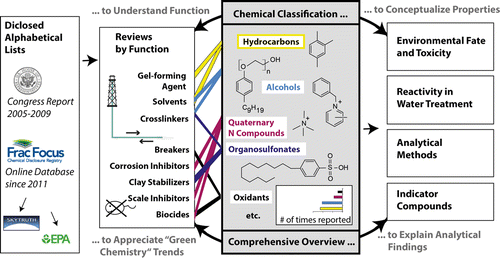How to get a handle on potential risks posed by fracking fluids

The latest skirmishes over hydraulic fracturing in Florida and California are, at their core, about water. Many fracking-related spills have been recorded, and opponents say that such incidents pose unacceptable threats to water supplies. But the issue is fraught with uncertainties. Scientists review what's known about the fluids in ACS' journal Environmental Science & Technology and conclude that a comprehensive assessment of potential risks requires full disclosure of fracking fluid contents.
The expansion of fracking in recent years has lowered energy costs for customers and is expected to continue its growth for the next several years, industry experts have reported. But the compounds used to crack shale formations to release their gas and oil reserves are under increasing scrutiny. While many are considered harmless, others are known toxins or carcinogens. And there are substances that oil and gas companies use in fracking operations that they don't disclose publicly. But in a recent review article, Martin Elsner and Kathrin Hoelzer note several reasons why these companies should list all the compounds involved.
The researchers say transparency could go a long way toward improving these operations. Among other benefits, full disclosure could allow for better monitoring of waterways for potential contamination. It also could help in assessing what new compounds might form from underground chemical reactions. Although some fluid additives might be non-toxic to start, they could react with other substances once injected into a well and form new potentially harmful products, the team explains. A complete listing could also contribute to improving the treatment of wastewater from fracking operations to remove potential toxins before they can contaminate aquifers, rivers and lakes. In addition to knowing the starting materials, the researchers say cataloging naturally occurring compounds that seep into the fluids from underground deposits is critical.
More information: Martin Elsner et al. Quantitative Survey and Structural Classification of Hydraulic Fracturing Chemicals Reported in Unconventional Gas Production, Environmental Science & Technology (2016). DOI: 10.1021/acs.est.5b02818
Abstract
Much interest is directed at the chemical structure of hydraulic fracturing (HF) additives in unconventional gas exploitation. To bridge the gap between existing alphabetical disclosures by function/CAS number and emerging scientific contributions on fate and toxicity, we review the structural properties which motivate HF applications, and which determine environmental fate and toxicity. Our quantitative overview relied on voluntary U.S. disclosures evaluated from the FracFocus registry by different sources and on a House of Representatives ("Waxman") list. Out of over 1000 reported substances, classification by chemistry yielded succinct subsets able to illustrate the rationale of their use, and physicochemical properties relevant for environmental fate, toxicity and chemical analysis. While many substances were nontoxic, frequent disclosures also included notorious groundwater contaminants like petroleum hydrocarbons (solvents), precursors of endocrine disruptors like nonylphenols (nonemulsifiers), toxic propargyl alcohol (corrosion inhibitor), tetramethylammonium (clay stabilizer), biocides or strong oxidants. Application of highly oxidizing chemicals, together with occasional disclosures of putative delayed acids and complexing agents (i.e., compounds designed to react in the subsurface) suggests that relevant transformation products may be formed. To adequately investigate such reactions, available information is not sufficient, but instead a full disclosure of HF additives is necessary.
Journal information: Environmental Science & Technology
Provided by American Chemical Society


















